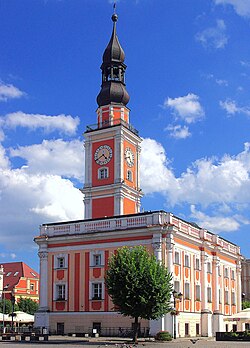Leszno
| Leszno | |||
|---|---|---|---|

Town Hall in Leszno
|
|||
|
|||
| Motto: "Leszno — rozwiń skrzydła" "Leszno — spread your wings" |
|||
| Coordinates: 51°51′N 16°34′E / 51.850°N 16.567°E | |||
| Country |
|
||
| Voivodeship |
|
||
| County | city county | ||
| Established | 14th century | ||
| Town rights | 1547 | ||
| Government | |||
| • Mayor | Łukasz Borowiak | ||
| Area | |||
| • Total | 31.9 km2 (12.3 sq mi) | ||
| Population (2014) | |||
| • Total | 64,612 | ||
| • Density | 2,000/km2 (5,200/sq mi) | ||
| Time zone | CET (UTC+1) | ||
| • Summer (DST) | CEST (UTC+2) | ||
| Postal code | 64-100 to 64-110 | ||
| Area code(s) | +48 065 | ||
| Car plates | PL | ||
| Website | www.leszno.pl | ||
Leszno [ˈlɛʂnɔ] (German: Lissa, between 1800 and 1918 also called Polnisch Lissa or Lissa in Posen) is a town in western Poland with 64,612 inhabitants (2014). Situated in the southern part of the Greater Poland Voivodeship since 1999, it was previously the capital of the Leszno Voivodeship (1975–1998). The town has county status.
The settlement probably arose in the 13th century. Leszno in the Polish Poznań Voivodeship was first mentioned in historical documents in 1393, when the estate was the property of Stefan z Karnina of Wieniawa Coat of Arms. The family adopted the surname of Leszczyński from the name of their estate according to the medieval custom of the Polish nobility.
Around 1516, a community of Protestant Unity of the Brethren refugees expelled from the Bohemian lands of King Vladislaus II settled in Leszno invited by the noble Leszczyński family, who were since 1473 Imperial counts and had converted to Calvinism. The arrival of the Bohemian Protestants as well as weavers from nearby Silesia helped the settlement to grow and made it possible to become a town in 1547 by a privilege according to Magdeburg Law given by King Sigismund I of Poland. Leszno was also the biggest printing center in Greater Poland thanks to the activity of the Protestant community, whose number increased because of inflow of refugees from Silesia, Bohemia and Moravia during the Thirty Years War. In 1631, Leszno was vested with further privileges by King Sigismund III Vasa, treating it as equal with the most important cities of Poland. At that time it already had a Gymnasium school led for a period by Jan Amos Komenský (known in English as Comenius) from Fulnek in Moravia, an educator who was a bishop of the Unity of the Brethren. From 1638 until his death in 1647, Johann Heermann, a German-speaking poet, lived in Leszno. Between 1636 and 1639, the town became fortified and its area increased.
...
Wikipedia



